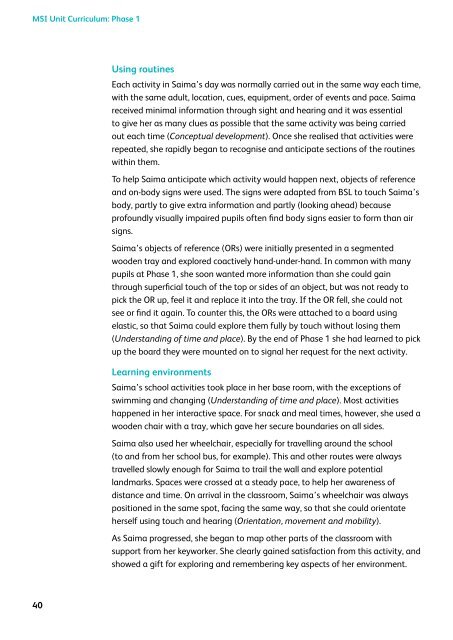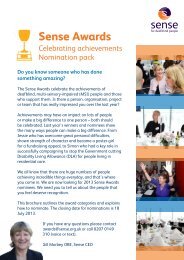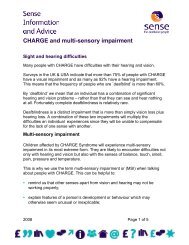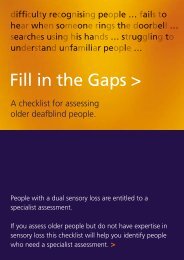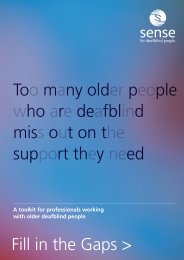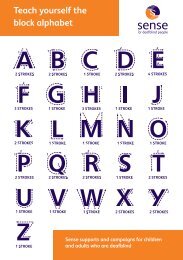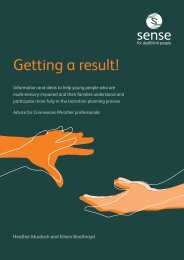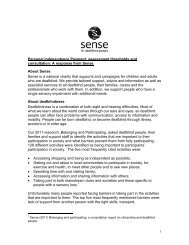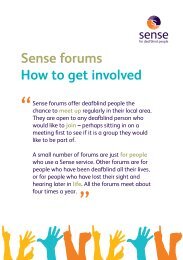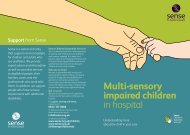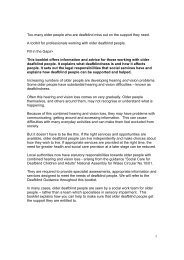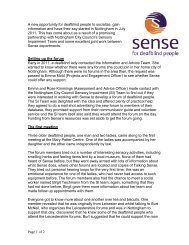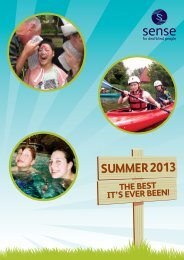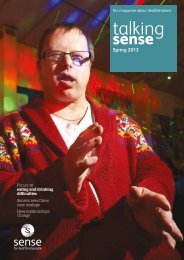MSI Unit Curriculum - Sense
MSI Unit Curriculum - Sense
MSI Unit Curriculum - Sense
You also want an ePaper? Increase the reach of your titles
YUMPU automatically turns print PDFs into web optimized ePapers that Google loves.
<strong>MSI</strong> <strong>Unit</strong> <strong>Curriculum</strong>: Phase 1Using routinesEach activity in Saima’s day was normally carried out in the same way each time,with the same adult, location, cues, equipment, order of events and pace. Saimareceived minimal information through sight and hearing and it was essentialto give her as many clues as possible that the same activity was being carriedout each time (Conceptual development). Once she realised that activities wererepeated, she rapidly began to recognise and anticipate sections of the routineswithin them.To help Saima anticipate which activity would happen next, objects of referenceand on-body signs were used. The signs were adapted from BSL to touch Saima’sbody, partly to give extra information and partly (looking ahead) becauseprofoundly visually impaired pupils often find body signs easier to form than airsigns.Saima’s objects of reference (ORs) were initially presented in a segmentedwooden tray and explored coactively hand-under-hand. In common with manypupils at Phase 1, she soon wanted more information than she could gainthrough superficial touch of the top or sides of an object, but was not ready topick the OR up, feel it and replace it into the tray. If the OR fell, she could notsee or find it again. To counter this, the ORs were attached to a board usingelastic, so that Saima could explore them fully by touch without losing them(Understanding of time and place). By the end of Phase 1 she had learned to pickup the board they were mounted on to signal her request for the next activity.Learning environmentsSaima’s school activities took place in her base room, with the exceptions ofswimming and changing (Understanding of time and place). Most activitieshappened in her interactive space. For snack and meal times, however, she used awooden chair with a tray, which gave her secure boundaries on all sides.Saima also used her wheelchair, especially for travelling around the school(to and from her school bus, for example). This and other routes were alwaystravelled slowly enough for Saima to trail the wall and explore potentiallandmarks. Spaces were crossed at a steady pace, to help her awareness ofdistance and time. On arrival in the classroom, Saima’s wheelchair was alwayspositioned in the same spot, facing the same way, so that she could orientateherself using touch and hearing (Orientation, movement and mobility).As Saima progressed, she began to map other parts of the classroom withsupport from her keyworker. She clearly gained satisfaction from this activity, andshowed a gift for exploring and remembering key aspects of her environment.40


